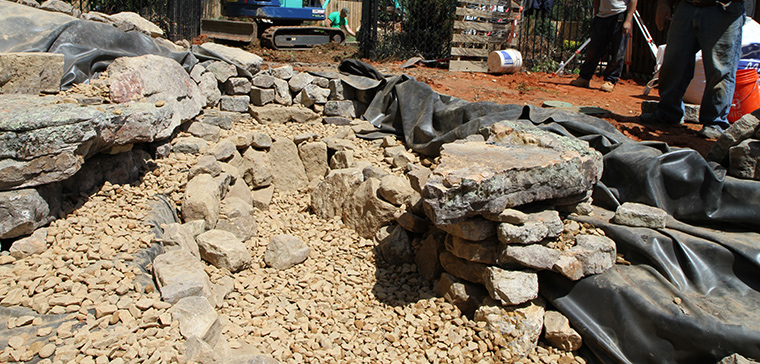Ponds 102 Chapter 6
Rock & Gravel - Simple Steps
One of the easiest and most popular designs for the inside of the pond is the so-called “Simple Steps” profile, where a series of 6-8” steps are dug to create shallow shelves down to the bottom of the pond. The great advantage of this design is that the shallow steps are easily faced with relatively small, manageable ‘one-man’ stones, which help to retain a layer of gravel completely covering each shelf. Proponents note that the shelves allow easy access in and out of the pond for safety; the increased surface area of the gravel beds provides more real estate for the bacteria that metabolize fish wastes; the gravel looks more natural than a bare liner and most importantly, the pond is fast and easy to construct in this manner. The procedure is simple: mark out the perimeter of the water feature and set the plumbed biological filter in place so the excavated soil can be thrown around it, creating the mound of the waterfall. Dig out the first shelf, level and 6-8” below grade. Move inward a foot or two and dig the next level down another 6-8”; repeat until the desired depth is reached. Install the skimmer at the end opposite the falls and connect to the line from the biofilter. Line the front of each step with stones to just above the height of the shelf to form a lip to hold the gravel, then cover all the shelves with 2-3” of gravel. Start filling the pond as the crew of three begins the stream. An 11’ x 16’ pond can typically be finished and running in a single day. The simplicity and speed of installation have made this style very popular, especially with beginner pondbuilders.

In the last few years, this method has started to fall out of favor for three main reasons. First, the pond ends up relatively shallow, with a lot of surface area relative to volume, so they tend to heat up more in the warm weather, cool down more quickly in winter, lose more water to evaporation and collect more leaves. Second, the shallow water around the edge makes the pond easily accessible to wading predators like raccoons, herons and egrets, provides a breeding ground for mosquitos where the fish can’t get to them and tends to heat up, increasing the growth rate of string algae. The third and greatest disadvantage is that the debris that accumulates in the gravel builds up over time and requires periodic cleaning, and the recommended method is to drain the pond and power wash the gravel, a time- and energy-consuming task that can leave fish and plants high and dry, often with tragic consequences.

One of the easiest and most popular designs for the inside of the pond is the so-called “Simple Steps” profile, where a series of 6-8” steps are dug to create shallow shelves down to the bottom of the pond. The great advantage of this design is that the shallow steps are easily faced with relatively small, manageable ‘one-man’ stones, which help to retain a layer of gravel completely covering each shelf. Proponents note that the shelves allow easy access in and out of the pond for safety; the increased surface area of the gravel beds provides more real estate for the bacteria that metabolize fish wastes; the gravel looks more natural than a bare liner and most importantly, the pond is fast and easy to construct in this manner. The procedure is simple: mark out the perimeter of the water feature and set the plumbed biological filter in place so the excavated soil can be thrown around it, creating the mound of the waterfall. Dig out the first shelf, level and 6-8” below grade. Move inward a foot or two and dig the next level down another 6-8”; repeat until the desired depth is reached. Install the skimmer at the end opposite the falls and connect to the line from the biofilter. Line the front of each step with stones to just above the height of the shelf to form a lip to hold the gravel, then cover all the shelves with 2-3” of gravel. Start filling the pond as the crew of three begins the stream. An 11’ x 16’ pond can typically be finished and running in a single day. The simplicity and speed of installation have made this style very popular, especially with beginner pondbuilders.

In the last few years, this method has started to fall out of favor for three main reasons. First, the pond ends up relatively shallow, with a lot of surface area relative to volume, so they tend to heat up more in the warm weather, cool down more quickly in winter, lose more water to evaporation and collect more leaves. Second, the shallow water around the edge makes the pond easily accessible to wading predators like raccoons, herons and egrets, provides a breeding ground for mosquitos where the fish can’t get to them and tends to heat up, increasing the growth rate of string algae. The third and greatest disadvantage is that the debris that accumulates in the gravel builds up over time and requires periodic cleaning, and the recommended method is to drain the pond and power wash the gravel, a time- and energy-consuming task that can leave fish and plants high and dry, often with tragic consequences.





